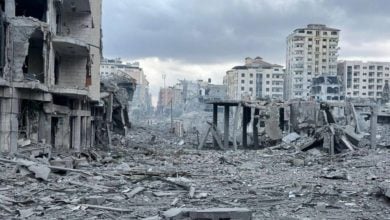The genocide of Native peoples and the enslavement of African peoples, “these are not mutually exclusive histories,” Melanie Yazzie (pictured above at mic) told a gathering of more than 350 people at an Albuquerque vigil in remembrance of the victims in Charleston.
“[They] worked in tandem to erect a system built on white supremacy, racial capitalism, and settler colonialism—a system we have yet to overcome!”
Standing together with Black leaders and congregants of several Albuquerque churches, Yazzie read a statement on behalf of the Red Nation and ANSWER Coalition calling for Native and Black unity with all oppressed people to build a more racially and politically just future.
‘You’re not welcome here in Albuquerque’
Like the racist oppression that continues to stalk Black communities after hundreds of years, one that creates a favorable environment for white-extremist terror, an atmosphere of racial terror reigns in the lives of Native Americans.
Police kill young Black men more than any other group. They kill Native Americans at a higher rate than any other group. Much of this violence happens in New Mexico, the state with the highest rate of police killing in the United Sates in 2014.
In a report issued by the Albuquerque People’s Tribunal on Police Brutality in March 2015, a community-led investigation found that:
Nearly every Native person interviewed described [Albuquerque Police Department’s] use of racial slurs, such as “dirty Indian.” They described encounters that began with APD officers telling them to “Go back to the reservation.” One Native man reported: “I was walking on the street and [a cop] was following me. I’d go down the alley and he’d follow me. ‘Why don’t you go back to the rez? You’re not welcome here in Albuquerque,’ he told me.”
According to the U.S. census, Native Americans make up 1.2 percent of the total population, but in New Mexico they make up 10.4 percent. Using the federally defined poverty level (as inadequate as that is) 18 percent of all New Mexicans live in poverty. The rate for Native Americans in New Mexico is 31 percent. Just over 25 percent of New Mexican children live in poverty versus 40 percent for Native American children.
In Albuquerque, 13 percent of all Native Americans experience chronic homelessness. Few statistics could better illustrate the crushing poverty and oppression that Native peoples face.
Unity in the face of a right-wing backlash
Bishop David C. Cooper of the New Hope Full Gospel Baptist Church, the largest African American church in Albuquerque, stated that the Charleston killings were part of a “Blacklash,” or a backlash against Black communities for standing up against the injustice of structural and systemic white supremacy, a struggle now epitomized by the Black Lives Matter movement and the rebellions in Ferguson and Baltimore.
“We are not tricked by mass media that calls young men who march and protest ‘thugs,’ and a young man that has admitted to the mass murder of nine people just a ‘suspect.’”
He echoed the need for unity when he said, “This is not about Black and white. This is about GREEN! This is about the one percent versus the 99 percent!”
Father Frank Quintana, a priest at the Blessed Oscar Romero Catholic Community, delivered a rousing exhortation. “Because my brothers and sisters, let me tell you, this is not a new problem of the 20th and 21st centuries. This is something that goes way back to the very foundation of this country. This nation was founded on genocide, racism, slavery and oppression!”






